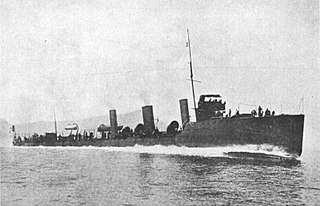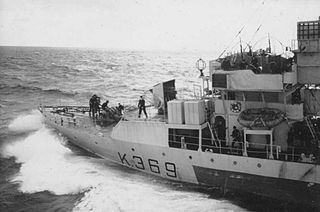Related Research Articles

USS John A. Moore (FFG-19), eleventh ship of the Oliver Hazard Perry class of guided-missile frigates, was named for Commander John Anderson Moore (1910–1944). Ordered from Todd Pacific Shipyards, Los Angeles Division, San Pedro, California on 28 February 1977 as part of the FY77 program, John A. Moore was laid down on 19 September 1978, launched on 20 October 1979, and commissioned on 14 November 1981.
HMCS Middlesex was a reciprocating engine-powered Algerine-class minesweeper built for the Royal Canadian Navy during the Second World War. Entering service in 1944, the vessel served as a convoy escort in the Battle of the Atlantic. Following the war, the ship ran aground on 2 December 1946 and broken up for scrap.

The Indomito class was a class of destroyers of the Italian Royal Navy before and during World War I. Six were built at Naples by Societa Pattison between 1910 and 1913. They were the first large Italian destroyers and the first fitted with steam turbines. The class is sometimes also called the I class. Two of the class were sunk during World War I, but the four surviving ships remained in service until 1937–38. One of the class, Insidioso, was reinstated during World War II and served in the Règia Marina and the German Kriegsmarine before being sunk by U.S. aircraft in late 1944.

HMCS Cobalt was a Flower-class corvette of the Royal Canadian Navy which took part in convoy escort duties during the Second World War. She served primarily in the Battle of the Atlantic. She was named for Cobalt, Ontario.

HMCS West York was a Flower-class corvette of the Royal Canadian Navy which took part in convoy escort duties during the Second World War. Named after Weston, Ontario, she was built by Midland Shipyards Ltd. in Midland, Ontario and commissioned on 6 October 1944 at Collingwood.

The Pará-class destroyers were a class of ten destroyers built for the Brazilian Navy between 1908 and 1910 by Yarrow in the Scotstoun district of Glasgow, Scotland. All were named after states of Brazil. The class closely resembled the British River-class destroyers. All ten ships were ordered under the 1907 Naval Programme and exceeded the design speed during sea trials, the best being Parana. The class proved very maneuverable with a turning circle of 375 yards at full speed. The class served in both World War I and World War II.

HMCS Brantford was a Flower-class corvette that served in the Royal Canadian Navy during the Second World War. She served primarily as a convoy escort in the Battle of the Atlantic. She was named for Brantford, Ontario.

HMCS Camrose was a Royal Canadian Navy Flower-class corvette which took part in convoy escort duties during the Second World War. She was named for Camrose, Alberta.

HMCS Galt was a Flower-class corvette of the Royal Canadian Navy that served during the Second World War. She saw action primarily in the Battle of the Atlantic. She was named after the city of Galt, Ontario.

HMCS Baddeck was a Flower-class corvette that served with the Royal Canadian Navy during the Second World War. She served in several theatres of operations during the war. After the war the ship was retired but the ship's name, pennant number and badge continue to be used by the K147 Baddeck Royal Canadian Sea Cadets Corps.

HMCS Drumheller was a Flower-class corvette that served with the Royal Canadian Navy during the Second World War. She served in several theatres, including the Battle of the Atlantic as an ocean escort. She was named for Drumheller, Alberta.

HMCS The Pas was a Flower-class corvette that served with the Royal Canadian Navy during the Second World War. She served primarily as an ocean escort in the Battle of the Atlantic and as a training ship. She was named for The Pas, Manitoba.

HMCS Owen Sound was a modified Flower-class corvette that served with the Royal Canadian Navy during the Second World War. She fought primarily in the Battle of the Atlantic as a convoy escort. She was named for Owen Sound, Ontario.

HMCS Smiths Falls was a modified Flower-class corvette that served in the Royal Canadian Navy during the Second World War. She fought primarily in the Battle of the Atlantic as a convoy escort. She was named for Smiths Falls, Ontario. She was the last Flower-class corvette to enter service with the RCN.

HMCS Royal Mount was a River-class frigate that served with the Royal Canadian Navy during the Second World War. She was used primarily as an ocean convoy escort in the Battle of the Atlantic. She was named for Mount Royal, Quebec, however due to possible confusion with HMCS Montreal, her name was switched around.

HMCS Poundmaker was a River-class frigate that served with the Royal Canadian Navy during the Second World War. It saw action as a convoy escort during the Battle of the Atlantic. She was named for the Poundmaker Cree Nation of Saskatchewan. After the war she was sold to Peru and renamed Teniente Ferré in 1947.

HMS Ettrick was a River-class frigate that fought for the Royal Navy and the Royal Canadian Navy during the Second World War. The vessel primarily saw action in the Battle of the Atlantic as a convoy escort. The ship was named for the Ettrick Water in Scotland.

HMS Monnow was a River-class frigate of the Royal Navy. The frigate served as a convoy escort in the Battle of the Atlantic during the Second World War. Named for the River Monnow in the United Kingdom, the vessel was transferred to the Royal Canadian Navy in 1944, keeping the same name, and finished the war with them. Returned to the Royal Navy following the war, it was sold to the Royal Danish Navy and renamed Holger Danske. It served until 1960 when it was scrapped. The ship is significant as it is one of the few ships employed by the Royal Canadian Navy never to visit Canada.
SS Howard E. Coffin was a Liberty ship built in the United States during World War II. She was named after Howard E. Coffin, one of the founders of the Hudson Motor Car Company and a charter member of The Society of Automotive Engineers and president in 1910.